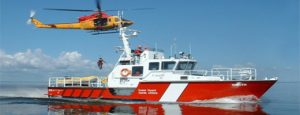 VICTORIA – The Canadian Coast Guard plays an important role in ensuring the safety of mariners and the protection of Canada’s marine environment and coastal communities. Through the $1.5 billion Oceans Protection Plan, the Government of Canada is working to improve marine safety and protect Canada’s waters and coasts today and for the future.
VICTORIA – The Canadian Coast Guard plays an important role in ensuring the safety of mariners and the protection of Canada’s marine environment and coastal communities. Through the $1.5 billion Oceans Protection Plan, the Government of Canada is working to improve marine safety and protect Canada’s waters and coasts today and for the future.
Terry Beech, Parliamentary Secretary to the Minister of Fisheries, Oceans and the Canadian Coast Guard, announced the official opening of the new Canadian Coast Guard search and rescue station in Victoria.
This new and modern search and rescue station is situated on Dallas Road alongside the Coast Guard’s Victoria base, with easy access to the harbour. The new building offers office and meeting space, as well as living quarters on the second floor for the station crew. Solar panels were installed on the roof of the building to offset a portion of the station’s energy consumption.
As with other Coast Guard search and rescue stations along the coast of British Columbia, the Victoria station is staffed 24-hours-a-day. The highly trained crews are ready to respond at a moment’s notice to a maritime emergency in the area, which is especially important during summer months when boating activity in the area increases for the season.
The station enhances marine search and rescue capacity in southern British Columbia and in the Strait of Juan de Fuca. It also supports Coast Guard’s longstanding partnerships with the Royal Canadian Marine Search and Rescue, Royal Canadian Navy, RCMP and local first responders.
The new building replaces a temporary station which opened in 2018.
The $1.5 billion Oceans Protection Plan is the largest investment ever made to protect Canada’s coasts and waterways. This national plan is creating a stronger marine safety system that provides economic opportunities for Canadians today, while protecting our coastlines and clean water for generations to come. This work is being done in close collaboration with Indigenous peoples, local stakeholders and coastal communities.
The station features a 14.7-metre Canadian Coast Guard lifeboat, the CCGS Cape Calvert, and a Rigid Hull Inflatable Boat, providing 24-hour response services for search and rescue, environmental response, and other activities. The marine infrastructure for the Victoria station vessels is projected for completion by 2023. The Victoria station is crewed by an Officer-in-Charge and three crew members, including an engineer and two Leading Seaman/Rescue Specialists.
The station cost $3.8 million to build and includes a double height workshop for vessel maintenance, a first aid room, as well as an equipment drying room and gear storage. Post-disaster construction standards were built into the station and include placing the electrical and communications room onto the second floor, rather than the first floor, in an effort to avoid tsunami water levels, should such a disaster occur.
As part of the Canadian Coast Guard’s Indigenous Community Boat Volunteer Pilot Program, for example, the Ahousaht First Nation received and launched its new dedicated response vessel. As a founding member of the Coastal Nations Coast Guard Auxiliary (CN-CGA), Ahousaht First Nation works and trains with the Canadian Coast Guard and other first responders to support marine safety on the west coast of Vancouver Island.
The Canadian Coast Guard is opening additional search and rescue stations in British Columbia as part of the Oceans Protection Plan to improve marine safety, protect Canada’s marine environment and coastal communities, and to support economic growth. This includes search and rescue stations in Hartley Bay and Tahsis, and a multi-purpose marine response facility planned in Port Renfrew.


